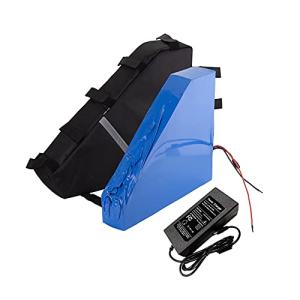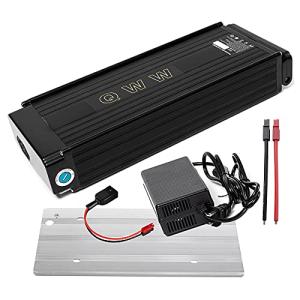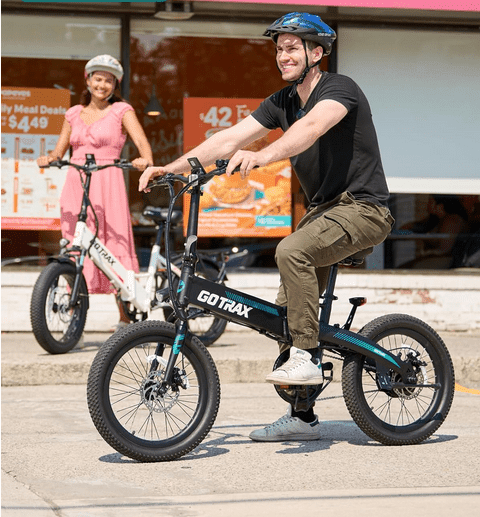"Charge Check: Solutions for a Fully Charged E-Bike That Won't Go"

You plug in your e-bike, and the battery shows full charge, but it just won't go—frustrating, right? In fact, abrupt power loss is a common hiccup for electric bike enthusiasts. This article will guide you through identifying and fixing the silent gremlins that keep your charged-up ride from hitting the road.
Stay tuned—the solution might be simpler than you think!
Key Takeaways
- If your e-bike battery shows a full charge but doesn't power the bike, it could be due to a faulty Battery Management System (BMS), hidden damage or loose connections.
- Simple checks like inspecting wires, cleaning battery terminals, and ensuring all connections are secure can help identify issues with an e-bike that won’t start.
- Regularly maintaining your e-bike's battery by keeping it clean, avoiding overcharging, balancing charges and updating firmware will prevent common problems and extend its life.
- Use tools like a digital multimeter to check if power is flowing correctly and try resetting the BMS or using a different charger if initial troubleshooting doesn't work.
- Store and charge your e-bike's battery in cool, dry places away from direct sunlight to avoid heat damage which can affect performance.
Understanding the Problem: E-Bike Battery Fully Charged but Not Working

Imagine your e-bike battery is full but won't turn on. This can be frustrating and confusing. The battery lights up, signaling a full charge, yet the bike remains lifeless when you press the throttle or peddle for assistance.
It's like having a fresh pack of batteries in a remote that just won't work - perplexing and annoying.
Several hidden factors could cause this tricky situation. Sometimes, it's as simple as an overlooked switch or a loose connection. Maybe the key switch isn’t turned on, even if everything else seems ready to go.
Other times, internal issues such as a malfunctioning Battery Management System (BMS) might block power flow despite the battery being charged. These little gremlins in your e-bike system need sleuthing to find and fix them before you can enjoy your ride again!
Possible Reasons for E-Bike Battery Issues
As e-bike enthusiasts power up only to find their rides unresponsive, the perplexity deepens – your battery shows a full charge but refuses to bring your bike to life. Discover the culprits lurking behind this baffling issue where all seems well with the battery's state of charge, yet nothing moves; it's time for some electronic sleuthing into what's stopping that electric power from hitting the road.
BMS Failures Preventing Power Flow
The Battery Management System (BMS) in your e-bike is key to making sure the battery works right. It controls power flow, monitors cell balance, and protects the battery from damage.
But sometimes it fails. A bad BMS might stop electricity even when your battery shows full charge.
Faulty wiring or internal errors can cause these failures. Your e-bike could seem dead if its BMS doesn't let power through to the motor. Check for a failed BMS with a digital multimeter - this tool measures volts and tells you if power isn't flowing.
If it's not, the BMS may need fixing or replacing to get you back on the road.
Unseen Battery Blunders
Batteries can hide secret problems you might not see right away. Tiny, hidden damages inside could stop your e-bike from working even if it looks fully charged. It's tricky because everything seems fine on the outside.
Look out for things like small breaks in wires or connectors that have come loose. These mishaps interrupt the flow of power silently.
Corrosion is another stealthy troublemaker that damages electrical connections over time—keep an eye out for any rusty or greenish spots on battery terminals. Sometimes, an electric bike will sit unused too long, and the lithium-ion cells inside lose their punch without making a fuss.
Regular use keeps them in good shape so they won't give up when you need them most!
Hidden Disconnections Leading to Power Loss
Wires in your e-bike can come loose without you noticing. This could stop the power from getting to where it needs to go. Bumps and vibrations during rides can shake connections free, especially on rough terrains.
The wiring harness might look okay from the outside but inside, a wire might have slipped out of place.
Check your bike's connectors if the power seems off even with a full charge. Corrosion or dirt can also cause bad connections. Clean them up and make sure they're plugged in tight. It keeps the electricity flowing right and helps avoid unexpected power loss while riding.
Thermal Issues Affecting Battery Performance
Now, consider another culprit behind battery troubles: heat. Too much warmth can harm your e-bike's power source. Like any electronic device, lithum-ion batteries hate getting too hot.
If they do, you might notice your bike's performance dropping or the battery charge not lasting as long.
E-bikes rely on a cool and stable temperature to keep their batteries happy and healthy. Charging in a warm area or leaving your e-bike in direct sunlight can lead to trouble. Heat damages the cells inside the battery, causing them to wear out faster than normal.
To avoid this, store and charge your e-bike's battery in a cool, dry place away from sunlight. It helps keep it running smoothly for many rides to come!
Visual Inspection: The First Step to Identify Issues
Before jumping into repairs, a visual check can reveal a lot about your E-bike's battery issues. It's a simple step that can save you from bigger problems later on.
- Look for loose connections: Examine all the wires and connectors to make sure they're tight and secure. A loose wire could be stopping power from reaching your motor.
- Check the battery case: Search for cracks, dents, or other damage on the battery case. Physical harm might lead to major battery problems.
- Inspect the terminals: Rust or dirt on battery terminals can block electricity flow. Make sure these points are clean and free of corrosion.
- Verify the charge indicators: Sometimes, indicator lights might not show the true charge level. If the lights seem off, there might be an issue with your charger or battery.
- Assess for proper seating: Your battery needs to fit correctly in its slot. If it’s not seated well, it won’t work right.
- Test brake lever connections: Faulty wiring at the brake levers can cause system cut-offs, so ensure these are properly connected.
- Observe any error codes: Modern E-bikes display error codes for specific issues. Note any unusual codes that pop up on your display panel.
- Confirm charger functionality: Use a different charger to see if your usual one might be faulty, as this is often mistaken for a battery problem.Preventive Maintenance Practices for a Healthy E-Bike Battery
An ounce of prevention is worth a pound of cure, especially when it comes to the lifeline of your e-bike—the battery. Engaging in preventive maintenance practices for your e-bike's power source not only extends its life but ensures you're never left pedaling harder than necessary.
Regular Battery Inspections
Check your e-bike battery often. Look for signs of damage, like cracks or leaks. A healthy battery should have clean and tight connections. Make sure wires are not loose or worn out.
Keep an eye on the charge level too – don't let it drop below 20% or go over 80%. This helps prevent cell imbalance and extends the life of your lithium-ion batteries.
Use a soft cloth to dust off the terminals during inspections. Dirt can block power flow and cause issues with charging. If you find any corrosion, gently clean it off with a mixture of baking soda and water.
Always disconnect the battery first to stay safe while cleaning connectors and checking for problems.
Cleaning of Connectors
Dirty or corroded connectors can cause big problems for your e-bike battery. They block the flow of power and make your fully charged battery act like it's empty. To keep your battery working well, you need to clean these connectors often.
Use a cloth to wipe away any dirt or grime gently. If corrosion is there, a bit of sandpaper can help scrub it off.
Make sure the connectors are dry and put them back together securely afterwards. This simple step can prevent annoying power cuts and keep you riding smoothly. Keep in mind, that a clean connection means more reliable rides!
Appropriate Charging Habits
Charge your e-bike battery with care to keep it going strong. Use the right charger for your bike and stick to the charging time recommended by the maker. This helps avoid damage from overcharging.
Keep your battery's power between 20% and 80%. Doing this can make your battery last longer.
After plugging in, check that everything is connected properly. Don't let the charger run all night. If you do, it could hurt the battery life. Next up – balancing those charges!
Balanced Charging
Balanced charging keeps your e-bike battery healthy. It makes sure that all the cells in your battery charge at the same rate and level. Picture a team of horses pulling a cart; if one horse is slower, the cart doesn't go straight.
The same happens with your battery cells. If they don't charge evenly, the whole battery won't work right.
Use a smart charger meant for your electric bike to maintain balance. This kind of charger takes care of each cell, making sure they all hit their best charge without going overboard or staying under-charged.
Sticking between 20% and 80% capacity also stops you from straining the cells too hard which can shorten their life. Keep this up and your rides will always start with plenty of power!
Firmware Updates
Firmware updates can breathe new life into your e-bike battery. They fix bugs and boost performance. Like a health checkup for your bike, keeping the software fresh is key to a smooth ride.
You'll want to update regularly — it's like giving your bike a brain refresh.
Follow the maker's steps closely when installing these updates. It helps keep your battery in top shape and avoids pesky connectivity issues. If you love zipping around on electric bikes without hiccups, keep that firmware up-to-date!
How to Fix Common E-Bike Battery Problems
Your e-bike's battery might look fine on the outside, but sometimes it just won't work. Handling common battery problems can get you back on the road in no time.
- Check your power supply first. Make sure your electric bike is getting power from the charger. If not, try a different outlet or charger to see if that's the issue.
- Look at your connectors. Dirty or loose connectors can stop power from reaching the battery. Clean them with alcohol and make sure they're snug.
- Inspect the Battery Management System (BMS). This system protects your battery but may fail and need resetting or replacing.
- Reset your e-bike battery. Some batteries have a reset button that fixes small glitches.
- Charge correctly with a proper charger. Always use the charger that came with your bike or one approved by the manufacturer to avoid damage.
- Follow balanced charging methods. Charge your battery to full then let it discharge to about 20% before recharging to keep it healthy.
- Update any software if needed. E-bikes with advanced systems may require firmware updates for better performance—check your manufacturer’s instructions.
- Perform regular checkups on your e - bike battery. Keeping an eye on its health can prevent many issues from happening in the first place.
- Avoid extreme temperatures when storing batteries—they work best in cool, dry places.
Conclusion
Finding out your e-bike battery is fully charged but won't work can be frustrating. Start with a simple visual check to spot any issues. Remember, keeping your battery healthy takes regular care and the right charging habits.
If problems persist, it's time for a pro to take a look. With these steps, you'll get back to smooth riding in no time!
FAQs
1. What could be wrong if my e-bike battery is fully charged but the bike won't move?
It's like a puzzle, right? When your e-bike doesn't budge even though the battery shows full charge, you might have an issue with the connection. Check the battery power cables and make sure they're snug and secure. Sometimes, it's as simple as a loose wire!
2. Should I take my e-bike to an auto mechanic if it has battery problems?
Actually, while an auto mechanic knows a lot about cars, for your e-bike woes, you're better off with a specialist who understands these rides inside out—think more along the lines of an "e-bike mechanic" rather than your car-savvy friend.
3. Could brakes or crank issues affect my e-bike’s battery performance?
You've got that right—the problem might not always be with the juice! If brakes are stuck or if something is jamming up in the crank area, even a fully charged battery can’t help you roll forward. Glance at those parts; they could be crying out for attention.
4. How often should I check my charger to keep my e-bike running smoothly?
Here's some advice: Treat your charger like that one app on your iOS device you can’t do without—check regularly! Some chargers play tricks on us by pretending to work when they’re not charging at all. Peek at it now and then just to be sure it’s living up to its name—battery charger!
Recent Featured Articles:
"Electrify the Trail: The Surge of Electric Mountain Biking"
DISCLAIMER
This document is provided for general information purposes only and should not be relied upon as providing legal advice, technical, or specific operational guidance to the reader, whether as to the practices described in the document or the applicable legal requirements and regulations. Sperry Madison., dba Just Electric Bikes, expressly disclaims any responsibility for liability arising from or related to the use or misuse of any information in this document.






